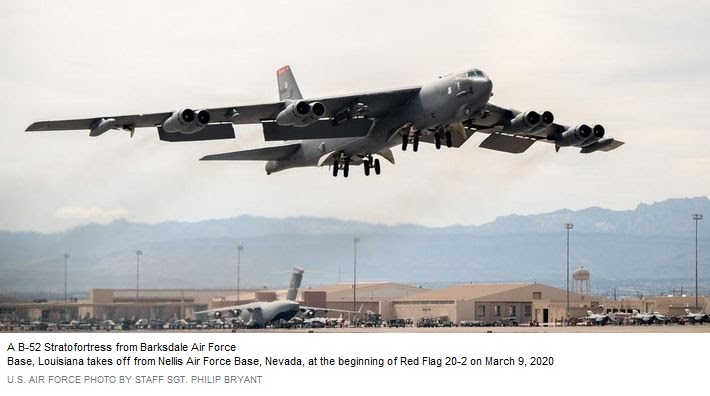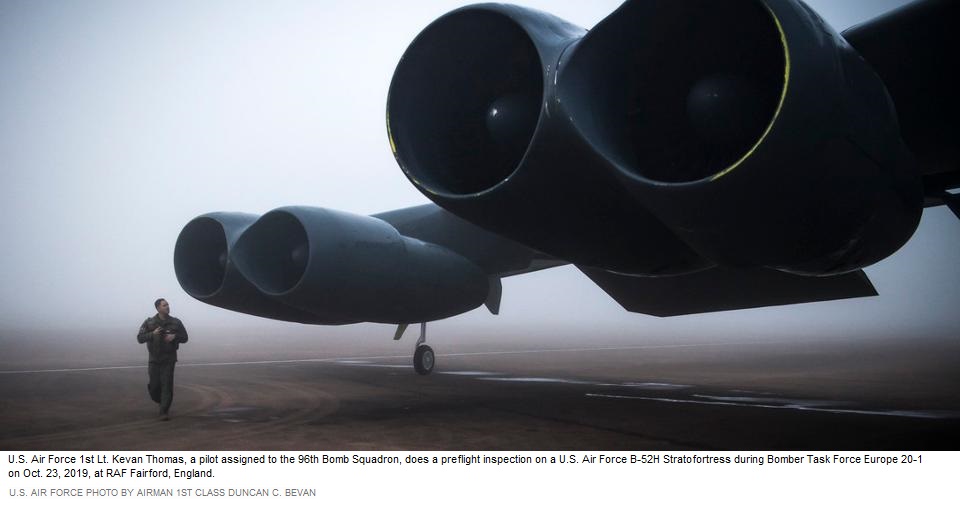
26 May Stop Calling The B-52 Bomber ‘Old’ — It’s More Youthful Than A B-2 Stealth Bomber by David Axe
The U.S. Air Force has asked industry to pitch a new engines for the service’s 76 B-52 bombers. With new motors, the B-52s could keep flying into the 2050s.
Or longer. The youngest B-52 rolled off Boeing’s Wichita production line in 1962. But it’s not fair to call the B-52 a 59-year-old airplane. Very little of any B-52 actually dates to the 1960s. In many ways, a B-52 is “younger” than airplanes from the 1980s and ’90s.
It’s not for no reason that, in 2018, the Air Force announced it would retire its 62 ’80s-vintage B-1Bs bombers and 20 newer B-2 stealth bombers by the 2030s, while retaining the the updated B-52s alongside a fleet of at least 100 new B-21 stealth bombers.
After decades of dithering, the Air Force on May 19 issued a request for proposals as part of the Commercial Engine Replacement Program. Responses are due in July ahead of a mid-2021 contract award.
General Electric GE, Pratt & Whitney and Rolls-Royce all plan to compete for the effort, which combined with other upgrades could cost U.S. taxpayers more than $20 billion. The winner will have to build 608 engines that fit the cowlings for the B-52’s current Pratt & Whitney TF-33s.
The Air Force wants the new motors to improve the B-52′s fuel-efficiency by at least 20 percent while maintaining its ceiling and take-off performance. A B-52 with TF-33s can carry 35 tons of bombs and missiles as far as 4,500 miles without aerial refueling at a top speed of 650 miles per hour.
A modern turbofan such as General Electric’s CF34-10 or Passport, Pratt & Whitney’s PW800 or Rolls-Royce’s F130 can operate for 30,000 hours or more between overhaul. The B-52 have racked up around 20,000 flight hours apiece over their nearly 60 years of service. Assuming the Air Force installs the B-52’s new engines in the late 2020s, the service might not need to remove them until, oh, 2090 or so.
Don’t laugh. Few plane designs aside from the DC-3 and the C-130 are likely to fly for more than 100 years. But the B-52 very well could join that exclusive club. After all, the bomber’s actual components aren’t actually that old.
Ask yourself what limits the service life of a warplane. To keep flying, a plane must be safe, economical and useful. The B-52 has met all three criteria since the 1950s. There’s no reason to doubt it will continue to meet them in 2050 or later.

The B-52 is safe. Built tough by Boeing, the B-52 “has good bones,” Gen. Robin Rand, then head of Air Force Global Strike Command, told Air Force Magazine prior to his 2018 retirement.
The most fragile element of a B-52 is the skin of its upper wing. Boeing replaced that skin in the late 1970s.
Every four years, a B-52 spends a few months at Tinker Air Force Base in Oklahoma, where workers strip off the plane’s paint, remove panels and inspect every component, repairing or replacing the broken ones.
That’s been going on for decades. ”I would be surprised if there’s an original rivet in any of those airplanes we have out on the ramp,” Col. Robert Durkin, commander of the 28th Bombardment Wing—a B-52 unit in South Dakota—told a reporter in 1983. “It’s been re-winged. It’s been re-skinned. It’s been re-tailed. It’s not an unsafe airplane.”
The B-52 is economical. It costs around $70,000 to fly a B-52 for one hour. That’s roughly the same as what a B-1 costs for an hour of flight, and half what a B-2 costs. And the B-52’s per-hour cost eventually could drop owing to the greater fuel-efficiency of the new motors.

The same simplicity that makes the B-52 so cheap to operate also makes it more reliable than other bomber types are. The B-52 fleet in 2019 boasted a mission-capable rate of 66 percent. The B-2’s rate was 61 percent. The B-1’s—an embarrassing 46 percent.
The B-52 is useful. It might not be fast like the B-1 is or stealthy like the B-2 is, but it doesn’t need to be. For high-intensity warfare—nuclear or conventional—the B-52 is a missile-truck. A wide range of new long-range missiles are in development to allow the B-52 to strike targets from hundreds or even thousands of miles away.
The Long-Range Stand-Off nuclear cruise missile. The Long-Range Anti-Ship Missile. The hypersonic Air-Launched Rapid-Response Weapon.
And to make it a better missile-truck, the Air Force is spending billions of dollars upgrading the B-52’s radios, wiring and sensors.
Arguably the most important of these upgrades is a new radar. The Air Force in 2019 tapped Raytheon to install a new electronically-scanned array radar on the B-52 starting in 2024. “The advanced radar upgrade will ensure the aircraft remains mission-ready through 2050 and beyond,” Raytheon stated.
If a bomber’s rivets, skin, engines, wiring, sensors and weapons are new, is the bomber actually old—even if its born-on date is 1962?
Reference:

Sorry, the comment form is closed at this time.